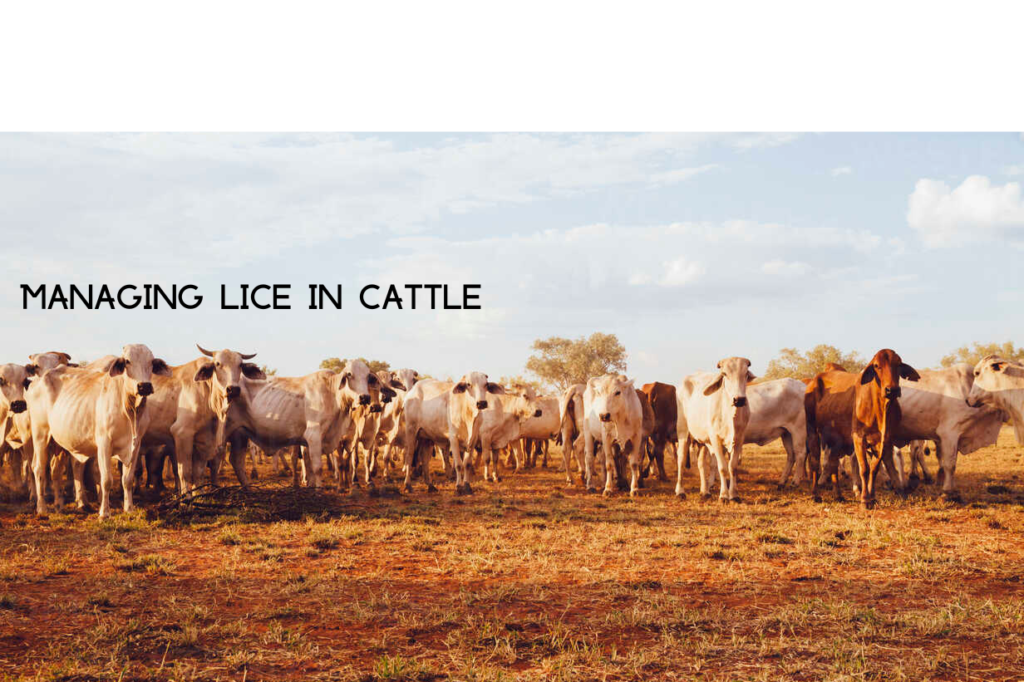
Wondering how to treat cattle with lice infestations?
Managing lice in cattle is essential not only for animal welfare, but also to protect the production and value of your herd. As well as leading to additional health issues, cattle rubbing infested areas on fences and gates can also cause expense to your farm infrastructure.
Problems with lice often occur after rain events at this time of year, and accurate identification of the critters, as well as proper and timely application of treatments is essential to manage the issue.
There are two types of cattle lice: biting lice and sucking lice.
Biting lice feed on skin debris and can cause severe irritation. The cattle biting louse (Bovicola bovis) is a reddish-brown louse about 2 mm long with a brown head. It is mostly found on the neck, shoulders, back and rump.
Sucking lice pierce the skin and suck blood. In large numbers they can cause anaemia. The short-nosed cattle louse (Haematopinus eurysternus) is dark grey. The female is 3.5 5 mm long. The male is smaller. It is mostly found around the cattle’s eyes and in the long hair around the neck and tail, but in heavy infestations it can occur anywhere in the hair coat. In summer it is found in and around the ears and under the tail.
Control
Insecticides and regulations
There are many commercially available insecticides registered for control of cattle lice. All must be used strictly in accordance with manufacturers’ directions. Read the label thoroughly. Pay particular attention to the withholding periods required for meat and milk production, and to compatibility with other treatments such as drenches. Refer to the cautionary notices at the end of this document.
Maximum residue limits (MRLs) are set for chemical/food combinations by Australian law.
Withholding periods (WHPs) are designed to ensure a safe time period between pesticide application and slaughter of livestock, so that any chemical residues that may exist in the final product (meat or milk) are below the MRL.
Export slaughter intervals (ESIs) have been developed for the red meat industry through Meat and Livestock Australia to reflect the differences between domestic and overseas MRLs. ESIs may be quite different to WHPs. Produce destined for overseas markets must satisfy the ESI. Read the product label carefully before use and adhere to the WHP and ESI time intervals.
Treatment methods
Most insecticides registered for use on cattle are not very active against louse eggs. This means that after treatment, eggs can still hatch and continue the infestation. With some insecticides, a follow-up treatment 23 weeks later is necessary. This time interval is critical to achieve control, as it allows time for the eggs to hatch but not to mature into adults which will lay eggs themselves.
The timing and frequency of treatments depend very much on individual circumstances. In many cases treatment in late autumn or early winter will give adequate control of cattle lice.
There are four methods of treatment available, but not all products control both biting and sucking lice, so check the label carefully and/or have the lice on your cattle identified. Spray-on and pour-on insecticides are probably the most widely used form of control, but insecticidal ear tags are also available. The injectable formulations of macrocyclic lactone (ML) worm drenches also control sucking lice.
Spray treatment
Hand spraying is practical for small numbers of cattle. Knapsack sprays, or any pump/spray unit with 0.70.8 mm spray nozzles capable of producing a ‘cone’ or ‘flat fan’ spray pattern, are suitable.
Commercial power spray units are also available. These are generally walk-through systems with one to three spray ‘hoops’. Cattle must be walked slowly through them to ensure adequate wetting.
With all spraying methods, thorough wetting of the cattle with the insecticide is essential.
Pour-on treatment
With pour-on treatments a small amount of insecticide is applied to the animal’s back. Depending on the product chosen, some insecticide will be absorbed across the skin and be moved throughout the body. Sucking lice that feed on blood are poisoned as they feed. Insecticide that remains on the skin and in the hair coat is distributed by cattle grooming. This residue aims to kill biting and sucking lice that come in contact with it. Treat all cattle with one of the treatments listed above and ensure that you repeat the treatment according to the manufacturer’s instructions.
1. Ensure that the dose rate is accurate. Preferably weigh all cattle, or a representative sample.
2. Treat all cattle on the property at the same time, prior to calving. Choose a time when they are not stressed or in poor condition.
OR
If groups are treated separately, ensure that there is no contact possible between treated and untreated groups.
3. Immediately after treatment, move treated groups to a paddock that has not had cattle in it for at least a week.
4. Ensure that no contact with any neighbours’ cattle is possible, either through straying or through contact across fences.
5. Check that treatment has been effective. No adult live lice should be found on the animals when they are brought in again for their second treatment, and there should be no live lice at all a few days after the second treatment.
6. Consider treating in autumn, before louse numbers build up. This will allow a longer ‘test period’ of cold weather to follow, so that you are better able to gauge whether eradication has been successful.
Check out our range of lice treatments for cattle here! Additional phone support with one of our experienced cattle health experts is available by calling 1300 327 626.
Join now for instant savings!
No Shipping Fee on your first order. Join now for instant savings! *T&C’s apply